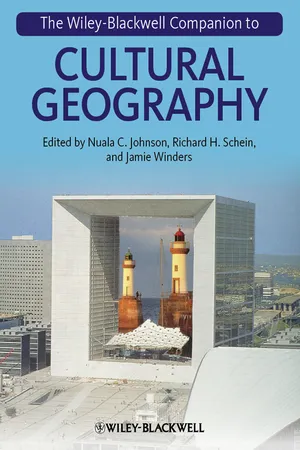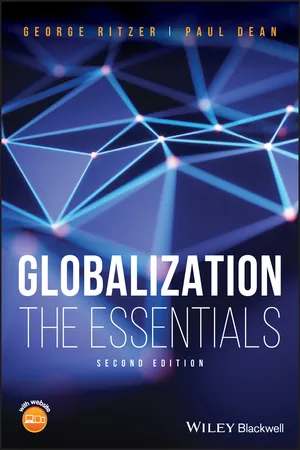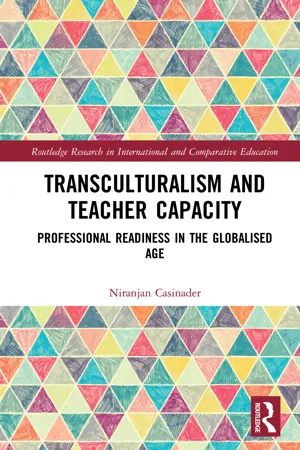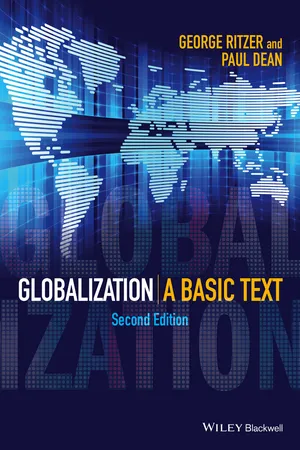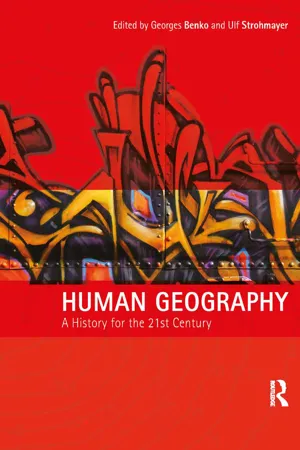Geography
Contemporary Cultural Diffusion
Contemporary cultural diffusion refers to the spread of cultural elements, such as ideas, beliefs, practices, and technologies, across different societies and regions in the modern world. This process is often facilitated by globalization, migration, trade, and communication technologies, leading to the blending and exchange of diverse cultural traditions and expressions. It is a key focus in understanding the interconnectedness of societies and the dynamics of cultural change.
Written by Perlego with AI-assistance
Related key terms
Related key terms
1 of 4
Related key terms
1 of 3
5 Key excerpts on "Contemporary Cultural Diffusion"
- Nuala C. Johnson, Richard H. Schein, Jamie Winders(Authors)
- 2013(Publication Date)
- Wiley-Blackwell(Publisher)
Although cultural geography developed historically and intellectually in relation to other areas of human geography, such as cultural ecology and social geography, it also has developed in relation to its practical and institutional contexts. Cultural geography means different things in different places and is enacted in different ways, especially between its North American and British variants (see, for example, Audrey Kobayashi’s discussion of this phenomenon in relation to geographic treatments of race in Chapter 9). Where cultural geography is performed, and where cultural-geographic research is produced, then, shapes what cultural-geographic scholarship looks like as much as does the widening array of spaces and places that cultural geographers now study. In all these ways, cultural geography, as a body of work, is as unruly as ever in its wanderings into other subdisciplines and disciplines, is as spatial as ever in the different strands of theories and writings that coexist as cultural geography in different places, and is as foundational as ever to the field of human geography in its interrogation of the relationship between the spatial and the social, landscape and cultural processes, past and present. The chapters commissioned for this new companion to cultural geography take up the difficult task of sorting through the unruliness, spatiality, and continuing centrality of contemporary cultural geography. The chapters are written by scholars who self-identify as cultural geographers and by geographers who write about cultural themes from the perspective of other subdisciplines. Thus, this companion reflects on the field of cultural geography from within and from without. While this approach might problematize the notion of a coherent subdiscipline, it also makes a claim about the continuity and relevance of cultural geography as a way of looking at the world, from the past to the future. That claim is especially salient today- eBook - ePub
Globalization
The Essentials
- George Ritzer, Paul Dean(Authors)
- 2018(Publication Date)
- Wiley-Blackwell(Publisher)
CHAPTER 7 Global Culture and Cultural Flows- Cultural Differentialism
- Civilizations
- Cultural Hybridization
- Muslim Girl Scouts
- Appadurai's “Landscapes”
- Cultural Convergence
- Cultural Imperialism
- Deterritorialization
- World Culture
- McDonaldization
- McDonaldization, Expansionism, and Globalization
- Beyond Fast Food
- The Globalization of Nothing
- Cricket: Local, Glocal, or Grobal?
- Cultural Imperialism
- Chapter Summary
Because much of it exists in the form of ideas, words, images, musical sounds, and so on, culture tends to flow comparatively easily throughout the world. In fact, that flow is becoming easier, because culture exists increasingly in digitized forms. Thus, the Internet permits global downloading and sharing of digitized cultural forms such as movies, videos, music, books, newspapers, photos, memes, and so on. Further, those who see themselves as part of the same culture can maintain contact with one another through email, social media, or via virtual face‐to‐face contact on Skype, Facetime, or other videochats. They can also remain immersed within the culture in which they exist and/or from which they come by, for example, reading online newspapers from home. While the global flow of digital culture is increasingly easy, the fact is that there are still barriers to it – especially, for many, a lack of access to the Internet, particularly in the South.While culture does flow comparatively easily across the globe, not all cultures and forms of culture flow with the same ease or at the same rate. For one thing, the cultures of the world's most powerful societies (most notably the United States) flow much more readily than those of relatively weak and marginal societies. Similarly, some types of culture (e.g. pop music) move quickly and easily around the globe, while others (e.g. innovative theories in the social sciences) move in slow motion and may never make it to many parts of the world. - eBook - ePub
Transculturalism and Teacher Capacity
Professional Readiness in the Globalised Age
- Niranjan Casinader(Author)
- 2019(Publication Date)
- Routledge(Publisher)
en masse to their former home. For them, migration was permanent, with the result that much of the learnings about cultural interaction and interweaving on a mass scale occurred within the regions of contact over time. The consequence was an inevitable adaption on the part of both the culture(s) of both the invaded and the invader, often leading to a new hybrid culture or culture(s) that became established and recognised as the signifier of that region over time. One older example includes the collective impact of the colonisations of Ancient Britain, which saw the culture(s) of the Britons interwoven with those of the Angles and Saxons (from present-day Germany), the Danes (Scandinavia) and the Romans. The original indigenous cultures around the Mediterranean have been merged with a number of imperial waves over the centuries, including the Roman, Ottoman, Phoenician and Moor. In more modern times, the Anglo-Indians of India and the Burghers of Sri Lanka are further examples of long-term hybrid cultures that have stemmed from demographic movement.So, if cultural meetings on a large scale have always been a feature of human history, what are the singular features about cultural interactions in the modern age that have led to a growing visible acknowledgement of a need for specific education in cultural understanding? There are two aspects of difference that seem to stand out: the demographic characteristics of modern cultural interaction; and the nature of modern cosmopolitanism.1.3.2 Contemporary cosmopolitanism
In the age of contemporary globalisation, and particularly since the start of the millennium, the salient demographic shift is that the degree, extent and frequency of cultural meetings between individuals from different societies have become greatly enhanced. It is now the norm for individuals to travel frequently from one cultural context to another, whether this be for work or pleasure. Those contexts are not just limited to international movement, but can equally apply to movements on an intra-national level, or even within a particular city. The need to adjust to cultural interaction occurring on a daily basis is now more acute, especially as national populations have become more diverse as a consequence of these more varied patterns of demographic travel. As outlined in a number of publications over the last two decades, one of the constant themes in the impact of globalisation upon education in schools has been the emergence of strong cultural diversity in student cohorts; see, for example, Clay and George (2000), Tikly (2001), Casinader (2015), and Watkins (2015). Another of these key aspects of demographic change that has emerged from globalisation has been the increased fluidity of human movement, both temporary and permanent, as people develop the capability and desire to move out of places of origin into different parts of the world to live and work. Modern technology in transport and communications has intensified the proportion of those who move temporarily, but it has also expanded the horizons of young people globally and shown them the possibilities that might exist in other parts of the world beyond the confines of their local origins. - eBook - ePub
Globalization
A Basic Text
- George Ritzer, Paul Dean(Authors)
- 2014(Publication Date)
- Wiley-Blackwell(Publisher)
CHAPTER 8 GLOBAL CULTURE AND CULTURAL FLOWS- Cultural Differentialism
- Civilizations
- Religion
- Cultural Hybridization
- Muslim Girl Scouts
- Salsa
- Appadurai’s “landscapes”
- Cultural Convergence
- Cultural imperialism
- World culture
- McDonaldization
- The globalization of nothing
- Sport: global, glocal, grobal
- Chapter Summary
Because much of it exists in the form of ideas, words, images, musical sounds, and so on, culture tends to flow comparatively easily throughout the world. In fact, that flow is increasingly easy because culture exists increasingly in digitized forms. Thus, the Internet permits global downloading and sharing of digitized cultural forms such as movies, videos, music, books, newspapers, photos, and so on. Further, those who see themselves as part of the same culture can maintain contact with one another through e-mail or via virtual face-to-face contact on Skype. They can also remain immersed within the culture in which they exist and/or from which they come by, for example, reading online newspapers from home. While the global flow of digital culture is increasingly easy, the fact is that there are still barriers to its flow, especially the lack of access by many (the “global digital divide”), mostly in the South, to the Internet.While culture does flow comparatively easily across the globe, not all cultures and forms of culture flow as easily or at the same rate. For one thing, the cultures of the world’s most powerful societies (most notably the US) flow around the world much more readily than the cultures of relatively weak and marginal societies. Similarly, some types of culture (pop music, for example) move quickly and easily around the globe, while others (innovative theories in the social sciences) move in slow motion and may never make it to many parts of the world.This chapter on culture permits the introduction of additional theories of globalization beyond the neoliberal and neo-Marxian theories discussed in Chapter 4 - eBook - ePub
Human Geography
A History for the Twenty-First Century
- Georges Benko, Ulf Strohmayer, Georges Benko, Ulf Strohmayer(Authors)
- 2014(Publication Date)
- Routledge(Publisher)
Whatever flower of culture each small region developed in its own garden plot was disseminated over the whole basin by the multitudinous paths of the sea. So varied were the local conditions of temperature, rainfall, soil, relief, area, coastline and vicinal grouping, that each district commanded some peculiar combination of natural advantages in the production of its distinctive contribution to the civilization as the whole. These cultural achievements in turn, transplanted to distant shores, took on new aspects in response to a changed environment or were remodeled by the genius of needs of new masters …(Semple 1931: 9–10)Diffusion research relied on a simple hypothesis: cultures were considered as sets of independent features. Each cultural feature was born in a specific place or culture area from which it had diffused. Thus the main objective of anthropology was to locate the places where cultural features were born and map the different phases of their diffusion. The interest in diffusion was strengthened by the neo-Lamarckian bent of many of the geographers who conceived human geography around 1900 (Roger 1979; Berdoulay and Soubeyran 1991; Soubeyran 1997).There was practically no discussion about the theoretical foundations of such a hypothesis: the idea that innovation could occur at the same time in different places was seldom considered, which impaired the value of the results. In spite of these inbuilt limitations, however, the diffusionist theory came to some interesting conclusions. In many cases, the hypothesis of a unique place of origin was coherent with observations, but something did not fit this general schema: the idea that cultural features were independent from each other. It soon became apparent that diffusion did not proceed at the same speed all the time and in all directions. In some areas, innovations were quickly adopted; in others, they were resisted. In the case of the diffusion of domesticated plants, for instance, crops which appeared as perfect substitutes for traditional ones were soon accepted: a new cereal was incorporated into the crop rotation system when it produced more abundant crops, provided the same food as the older ones and withstood more efficiently the local natural hazards. When the new crop involved new modes of consumption, the process was slower. In Europe, the standard diet was based on grain, not on roots: hence the long delay before the potato was integrated into crop systems, in spite of its high performance as a food crop.
Index pages curate the most relevant extracts from our library of academic textbooks. They’ve been created using an in-house natural language model (NLM), each adding context and meaning to key research topics.
Explore more topic indexes
Explore more topic indexes
1 of 6
Explore more topic indexes
1 of 4
